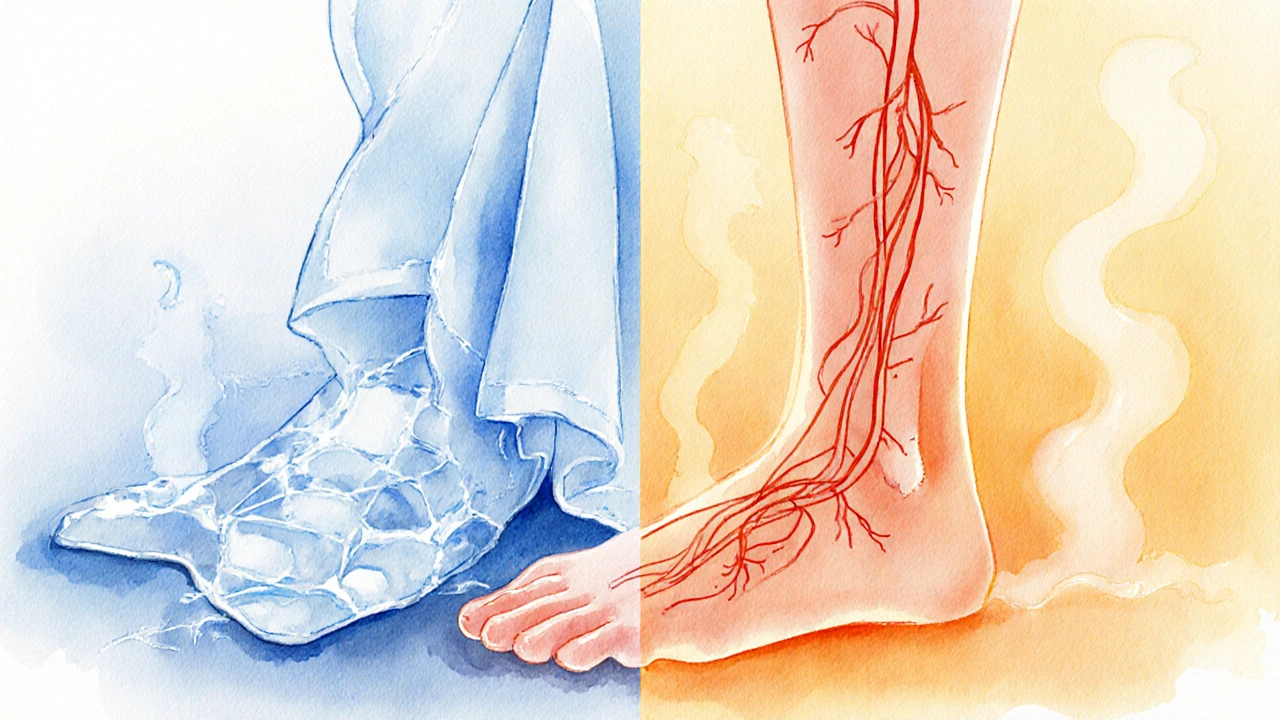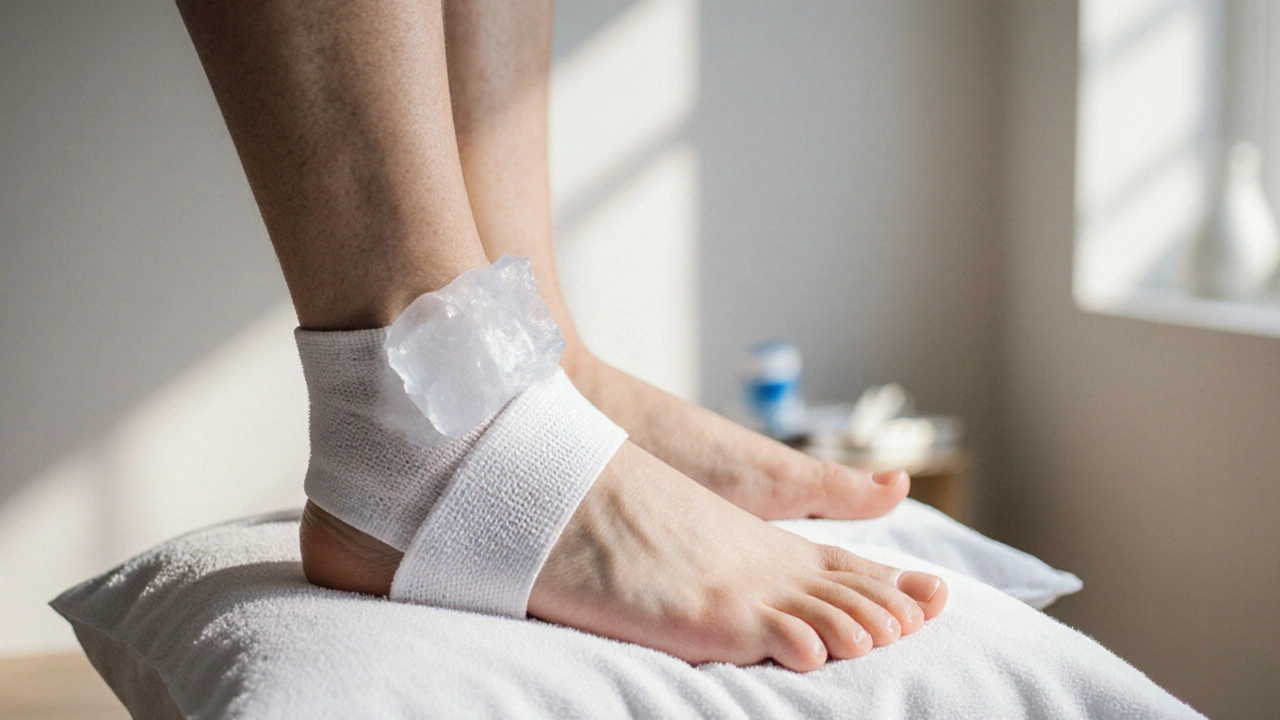Injury Treatment Advisor
This tool helps determine whether to use cold or heat therapy based on the time since injury and symptoms.
When you twist your ankle or bump your shin, Swelling is the body’s natural inflammatory response that traps fluid in the surrounding tissues, causing puffiness, pain, and limited movement. It’s the first sign that something’s gone wrong, but it doesn’t have to stall your comeback. Below you’ll find the exact steps to calm the puffiness, regain motion, and get back to the activities you love.
Quick Take
- Apply cold within the first 2hours to shrink blood vessels.
- Keep the injured area above heart level for 48hours.
- Use a snug but not tight bandage for compression.
- Move gently after swelling subsides to boost circulation.
- Add anti‑inflammatory foods like ginger and omega‑3s.
What Actually Happens When You Swell?
Inflammation is the body’s alarm system. When tissue fibers tear, blood vessels leak plasma, white blood cells rush in, and a cascade of chemical messengers tells the area to retain fluid. This fluid‑rich environment protects the injured cells but also creates the uncomfortable bulge we call swelling. The more severe the trauma, the stronger the inflammatory signal, and the longer the fluid stays trapped.
Two key processes drive the swelling:
- Increased vascular permeability - tiny gaps open in capillaries, letting plasma escape into the tissue.
- Lymphatic overload - the lymph system tries to drain the excess fluid, but it can’t keep up initially.
Understanding these mechanisms helps you target each step with the right remedy.
The First 48 Hours: RICE to the Rescue
The classic RICE protocol (Rest, Ice, Compression, Elevation) remains the gold standard because it addresses the two root causes above.
- Rest: Limit movement that stresses the injured fibers. Too much motion can reopen micro‑tears and reignite inflammation.
- Ice: Cold therapy Ice therapy constricts blood vessels, reducing the leak of plasma. Apply a thin towel‑wrapped ice pack for 15‑20minutes every 2‑3hours. Avoid direct skin contact to prevent frostbite.
- Compression: A elastic bandage Compression provides gentle pressure that limits the space fluid can occupy. Aim for a snug wrap that’s firm but allows a fingertip to slip underneath.
- Elevation: Raising the limb above heart level uses gravity to aid venous return. Prop it on pillows or a chair for the first two days.
These steps work together: Ice cuts the blood flow, compression squeezes out excess fluid, and elevation drags it back toward the heart where the lymph system can finally handle it.
Beyond the Basics: Advanced Strategies After 48 Hours
Once the acute puffiness eases, you can layer on additional tactics to keep the recovery moving forward.
- Gentle Active Motion: Light range‑of‑motion exercises (ankle circles, wrist flex‑extend) stimulate the lymphatic pumps without overloading the tissue.
- Heat Therapy: After the first 48‑72hours, heat Heat therapy dilates vessels, encouraging fresh blood flow and “clean‑up” cells. Use a warm compress for 15minutes, twice a day.
- Massage & Lymphatic Drainage: A soft, rhythmic massage towards the nearest lymph nodes can accelerate fluid removal. Professional lymphatic drainage is especially helpful for larger bruises or post‑surgical swelling.
- Anti‑Inflammatory Nutrition: Foods rich in omega‑3 fatty acids (salmon, chia seeds), ginger, turmeric, and berries contain compounds that blunt the inflammatory cascade.
- Topical NSAIDs: Creams containing diclofenac or ibuprofen can provide localized relief without the gastrointestinal side effects of oral pills.

Cold vs. Heat: Knowing When to Use Which
| Aspect | Cold Therapy | Heat Therapy |
|---|---|---|
| When to use | First 48hours after injury | After swelling reduced (usually 48‑72hrs) |
| Effect on blood flow | Constricts vessels, limits fluid leakage | Dilates vessels, increases circulation |
| Typical duration per session | 15‑20minutes | 15‑20minutes |
| Best for | Pain, bruising, acute inflammation | Stiffness, muscle soreness, chronic pain |
Common Pitfalls that Prolong Swelling
Even with a solid plan, a few missteps can undo your progress.
- Skipping Compression: Without pressure, fluid re‑accumulates quickly.
- Leaving the Limb Below Heart: Gravity works against you, pushing fluid back into the injured area.
- Over‑icing: More than 20minutes per session can cause nerve irritation and actually increase swelling after the cold wears off.
- Re‑injuring the Area: Jumping back into high‑impact activity too soon restarts the inflammatory cycle.
- Ignoring Nutrition: A diet high in refined sugars fuels inflammation, slowing healing.
When to Call a Professional
Most minor bumps clear up within a week, but seek medical help if you notice any of these signs:
- Swelling that spreads beyond the immediate injury site.
- Severe pain that isn’t eased by ice or over‑the‑counter meds.
- Visible deformity or inability to bear weight.
- Fever or redness that looks like an infection.
- Swelling persisting longer than 10‑14days without improvement.
A physiotherapist can tailor a rehab program, while a doctor may rule out fractures or deeper tissue damage.
Quick Checklist Before You Rest
- Clean the area and apply a thin ice pack (15min).
- Wrap with a compression bandage, checking for tingling.
- Prop the limb on pillows to keep it elevated.
- Limit weight‑bearing or use crutches if needed.
- Schedule gentle range‑of‑motion moves after the first 24hours.
Frequently Asked Questions
How long should I keep my injury elevated?
Aim for at least the first 48hours. Keeping the limb above heart level for the full two days reduces fluid buildup by up to 30% compared with lying flat.
Can I use a heating pad right after an injury?
No. Heat increases blood flow, which can worsen the initial swelling. Switch to heat only after the first 48‑72hours and when the swelling has visibly decreased.
Is it safe to take an oral NSAID with a topical one?
Generally yes, but keep the total dosage within the recommended limits. If you have stomach issues or are on blood thinners, talk to a pharmacist first.
What foods help reduce swelling?
Omega‑3 rich fish (salmon, sardines), walnuts, chia seeds, turmeric, ginger, and colorful berries all contain anti‑inflammatory compounds that can shorten swelling time by a few days.
Should I massage a swollen area?
Gentle lymphatic‑drainage massage is beneficial after the first 48hours. Avoid deep tissue pressure while the area is still tender; it can push fluid deeper and delay healing.


Terri DeLuca-MacMahon
September 30, 2025 AT 21:26Hey team!! 🎉 You’ve got this!! Keep that ice pack on for 15‑20 minutes every couple of hours and watch the swelling shrink!! Remember to elevate above heart level – it’s a game‑changer!! 🌟 Stay positive, stay moving, and soon you’ll be back on your feet!! 💪
gary kennemer
October 10, 2025 AT 19:15From a physiological standpoint, the initial vasoconstriction caused by cold reduces capillary permeability, which directly limits fluid extravasation. Pairing that with compression creates a pressure gradient that encourages venous return. Elevation then uses gravity to further assist lymphatic drainage. Once the acute phase subsides, gentle range‑of‑motion exercises stimulate the muscular pump without overloading the tissue. The transition to heat after 48‑72 hours promotes angiogenesis and metabolic clearance, completing the healing cascade.
Payton Haynes
October 20, 2025 AT 17:04Ice works best within the first two hours after injury.
Earlene Kalman
October 30, 2025 AT 13:53This guide glosses over the fact that many people simply ignore compression or apply it too tightly, which can actually impede circulation. It also fails to mention that prolonged icing beyond 20 minutes may cause nerve irritation and paradoxical swelling. The “quick checklist” feels like a checklist for the uninformed rather than a nuanced protocol for seasoned athletes.
Dominique Watson
November 9, 2025 AT 11:42It is evident that the principles outlined align with the long‑standing medical traditions upheld across the United Kingdom, where evidence‑based practice is paramount. The emphasis on measured progression and avoidance of premature exertion reflects the disciplined approach championed by our NHS clinicians, a standard that should be emulated globally.
Mia Michaelsen
November 19, 2025 AT 09:31While the RICE protocol is indeed foundational, recent literature suggests integrating “MEAT” – Movement, Exercise, Analgesics, and Therapy – during the sub‑acute phase to accelerate collagen remodeling. Moreover, incorporating omega‑3 supplementation has been shown to modulate eicosanoid pathways, thereby reducing pro‑inflammatory cytokine expression. These nuanced additions can meaningfully shorten recovery time beyond the generic checklist.
Kat Mudd
November 29, 2025 AT 07:20The swelling after an injury is essentially fluid leaking into the interstitial spaces.
Your body does this to protect the damaged cells from further harm.
The first step is to stop the bleeding inside the tissue by constricting the vessels.
Applying ice causes vasoconstriction which limits the amount of plasma that can escape.
Compression then adds external pressure that keeps the fluid from accumulating further.
Elevation uses gravity to pull the excess fluid back toward the heart.
All three actions work together like a coordinated response to the trauma.
After the initial 48 hours the inflammatory cascade begins to subside.
At this point heat can be introduced to promote vasodilation and metabolic clearance.
Gentle movements stimulate the lymphatic pump without reopening the torn fibers.
Nutrition plays a role because omega‑3 fatty acids interfere with prostaglandin synthesis.
Ginger and turmeric contain bioactive compounds that further dampen inflammation.
Topical NSAIDs provide localized pain relief without systemic side effects.
Consistency is key because intermittent application loses its therapeutic benefit.
Finally, monitoring for signs of infection or worsening pain ensures you seek professional care when needed.
Pradeep kumar
December 9, 2025 AT 05:09Let’s adopt a holistic framework: start with cryotherapy to attenuate the inflammatory cascade, then transition to thermotherapy as the reparative phase initiates. By leveraging mechanotransduction through low‑intensity active range‑of‑motion drills, you stimulate endothelial shear stress which enhances lymphatic clearance. Pair this with a nutraceutical regimen rich in EPA/DHA and curcumin, and you create a synergistic milieu that expedites tissue remodeling. Keep the mindset positive and the protocol consistent – the body’s innate healing capacity will do the rest.
James Waltrip
December 19, 2025 AT 02:59One must acknowledge that mainstream recovery protocols are deliberately watered down by conglomerates seeking to sell endless products. The true path to rapid resolution lies in ancient, peer‑reviewed techniques that have been suppressed, such as contrast hydrotherapy cycles and targeted myofascial release guided by bio‑feedback. By rejecting the cookie‑cutter RICE dogma and embracing a renaissance of individualized, evidence‑rich interventions, the informed patient can outpace the average recovery timeline with elegance and efficacy.